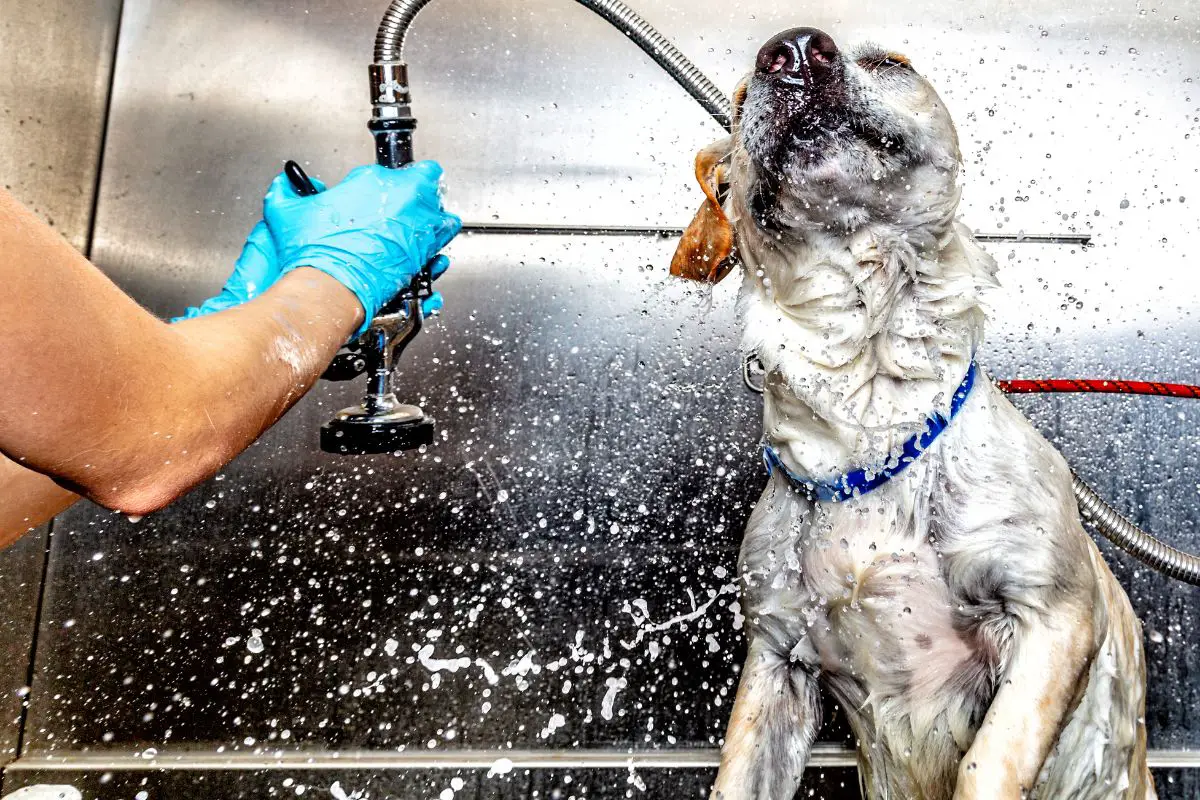As temperatures rise and outdoor activities increase, proper grooming becomes crucial for your dog’s comfort and health during the summer months.
From managing shedding to protecting against parasites, these seven grooming tips will help keep your furry friend cool, clean, and happy throughout the summer season.
1. Regular Brushing
Increase the frequency of brushing sessions during summer to manage shedding and prevent matting.
Daily brushing helps remove loose fur and distribute natural oils throughout the coat.
Use a brush appropriate for your dog’s coat type, such as a slicker brush for long-haired breeds or a bristle brush for short-haired dogs.
Brushing outdoors can help contain loose fur and keep your home cleaner.
Regular grooming sessions provide an opportunity to check for any skin issues or parasites.
Brushing can be a bonding experience and help your dog associate grooming with positive attention.
For dogs that resist brushing, start with short sessions and gradually increase duration as they become more comfortable.
2. Proper Bathing Techniques
While regular bathing is important, avoid over-bathing as it can strip natural oils from your dog’s skin and coat.
Use lukewarm water and dog-specific shampoo to avoid skin irritation.
Pay special attention to areas prone to dirt accumulation, such as paws and underbelly.
Rinse thoroughly to remove all shampoo residue, which can cause skin irritation if left behind.
Consider using a leave-in conditioner to keep your dog’s coat soft and manageable.
Always dry your dog thoroughly after bathing, especially in areas prone to moisture retention.
For dogs that dislike baths, try using positive reinforcement techniques to make the experience more enjoyable.
3. Paw Care
Regularly inspect and clean your dog’s paws, especially after outdoor activities.
Trim the hair between paw pads to prevent matting and reduce the collection of debris.
Check for any cuts, thorns, or other foreign objects that may have become lodged in the paws.
Apply a pet-safe paw balm to protect against hot pavement and maintain paw pad health.
Keep nails trimmed to prevent discomfort and potential injuries during summer activities.
Consider using dog boots for protection during walks on hot surfaces or rough terrain.
Rinse paws after beach visits to remove salt and sand, which can cause irritation.
4. Ear Cleaning
Check and clean your dog’s ears regularly, especially after swimming or playing in water.
Use a veterinarian-approved ear cleaner and soft cloth or cotton ball to gently clean the outer ear.
Never insert anything into the ear canal, as this can cause injury or push debris further in.
Look out for signs of ear infections, such as redness, swelling, or unusual odor.
For dogs prone to ear infections, consider using a drying solution after water activities.
Trim excess hair around the ears to improve air circulation and reduce moisture retention.
If your dog shows discomfort during ear cleaning, consult with your veterinarian for advice.
5. Parasite Prevention
Regular grooming provides an opportunity to check for fleas, ticks, and other parasites.
Use a flea comb to detect and remove any fleas or flea dirt from your dog’s coat.
Check for ticks, especially in areas like ears, neck, and between toes after outdoor activities.
Consult with your veterinarian about appropriate flea and tick prevention methods for your dog.
Consider using pet-safe insect repellents when spending time outdoors in bug-prone areas.
Regularly wash your dog’s bedding and vacuum your home to help control flea populations.
Remember that some parasites, like heartworms, require year-round prevention in many areas.
6. Coat Trimming
For long-haired breeds, consider a summer trim to help keep your dog cool.
Consult a professional groomer to ensure the trim is appropriate for your dog’s breed and coat type.
Avoid shaving double-coated breeds, as their undercoat provides natural insulation and sun protection.
Pay special attention to areas prone to matting, such as behind the ears and under the legs.
Trim hair around the eyes to improve visibility and reduce eye irritation.
For dogs with thick coats, consider thinning rather than a full cut to maintain some natural protection.
Remember that a dog’s coat helps regulate body temperature, so don’t trim too short.
7. Dental Care
Summer is a great time to establish or maintain a regular dental care routine for your dog.
Brush your dog’s teeth regularly using a dog-specific toothbrush and toothpaste.
Consider dental chews or toys to help reduce plaque buildup between brushings.
Check for signs of dental issues such as bad breath, swollen gums, or difficulty eating.
Provide plenty of fresh water to help rinse your dog’s mouth and promote overall oral health.
Consider scheduling a professional dental cleaning if it’s been a while since your dog’s last check-up.
Remember that good dental hygiene contributes to your dog’s overall health and well-being.
Conclusion
Proper summer grooming is essential for keeping your dog comfortable, healthy, and happy during the warmer months.
By incorporating these seven tips into your grooming routine, you can help prevent common summer issues and strengthen your bond with your furry companion.
Remember to always be patient and gentle during grooming sessions, making them a positive experience for both you and your dog.
Share this article on Facebook to help fellow dog owners keep their furry friends well-groomed and comfortable this summer!
Your friends might appreciate these tips for maintaining their dogs’ coats, paws, and overall health during the hot season.
SHARE now with your friends!
- Hero Farm Dog Survives Epic Battle with Coyote Pack - December 9, 2024
- The 10-Minute Bedtime Routine That Changed My Dog’s Sleep Forever - November 29, 2024
- Creating a Safe Space for Nervous Pets: Your Guide to Pet-Friendly Havens - November 25, 2024

